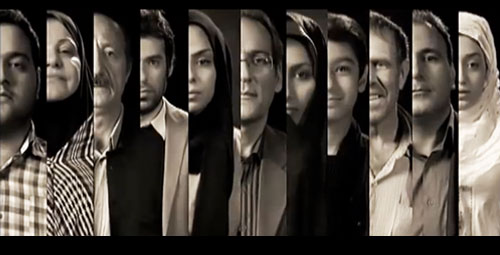New Voyager! Yes, We Can
by Yaghoub Yadali and translated by Parvaneh Torkamani / December 17, 2013 / No comments
Does a new YouTube video signal big changes in Iranians’ daily lives?

Still from 'New Voyager' a video directed by Hossein Dehbashi. Photo: President Rouhani via YouTube.
Lately in Iran, on Hassan Rouhani’s one hundredth day as president, a video entitled “New Voyager” was released on the internet. In several different ways it has caused a controversy.

- “Enemy…terrorism…nuclear bomb…war.” These words are often used by American media to describe Iran. The image the media presents is often hazy, incomplete, and distorted. The political and military aspects of my country are covered mainly in a negative light.
- In Under Eastern Eyes (I have adopted the name from the novel Under Western Eyes by Joseph Conrad), I will write about those topics which American media either cannot or does not want to talk about. The emphasis will be on social and cultural aspects of Iran although, out of necessity, I will talk about politics, despite my despair.

- Yaghoub Yadali, born in 1970, is a writer and television director. His first work of fiction, the short-story collection Sketches in the Garden, was published in 1997. It was followed in 2001 by Probability of Merriment and Mooning, which was named book of the year by the Writers and Critics Award. His first novel, The Rituals of Restlessness, won the 2004 Golshiri Foundation Award for the best novel of the year and was named as one of the ten best novels of the decade by the Press Critics Award. He has also published many articles and reviews of literature and cinema in newspapers and magazines in Iran.
The first issue is the video’s similarity in form and content to a clip President Obama published during his 2008 campaign, called “Yes We Can.” This has drawn criticism from many of President Rouhani’s conservative opponents in Iran. The interesting thing is that in order to show the similarities between the two clips some hardline conservative websites have had to show Obama’s video. Only, they’ve censored parts of it. Nine shots in the video are covered by black boxes.
On the other hand, Rouhani’s video has been very popular among his supporters, and according to the director, Hassan Dehbashi, in the first 24 hours it was seen four hundred thousand times.
It seems like those who ordered the video and those who made it have tried to portray a fresh and, if possible, a comprehensive image of Iran. In this video we see women singing along to Rouhani’s speeches. (In Iran, a woman can only sing for a female audience.) We also hear the voice of Mohammad Mossadegh, the popular democratic prime minister of the 1950s, who hasn’t been valued much in the government’s recent political campaigns. Furthermore, the video tries to show actors of different ages from different classes and ethnicities with a diverse mix of popular modes of dress and coverings. In this aspect, an almost real image of women has been successfully depicted. But not so in regards to men. The style of the young Iranian male is absent from this clip. Also, these days most Iranian men do not wear beards, and in this clip the attention paid to that physical aspect is more than what’s seen in everyday society.
The other point is the content of the video, which seems like it wants to express to the world President Rouhani’s doctoring of peace with the Iranian people in the best and most plausible way. To that effect, the publication of this clip coincided with the publication of the president’s one hundred day report. President Rouhani dedicated a great part of this report to the nuclear file, foreign policy, and the economy, but internal diplomacy and culture are covered in only a few sentences. From the makeup of his cabinet one can also predict his priorities: Except for the foreign ministry and the economic sector, which have been put into the hands of technocrats or reformists, all other ministries have been put into the hands of conservative ministers. Perhaps publishing this clip is a cultural and artistic compensation to those interested in culture and art. Without reading into the motivations of those who made the clip, one could say that the diversity present in the video’s form gives a realistic image of today’s Iran without exaggeration or shortcoming; in content the video tries to put forward an Iran that could, or should be.
Many Iranians hope that President Rouhani can soften the situation of security in Iran and permit some breathing room for thought and culture, while also releasing the country from the dreadful pain of American, European, and Security Council sanctions. Aside from showing the world’s government and people the Iran that Rouhani envisions, it seems that making and publishing this clip is also an attempt at emboldening the Iranian people’s hopes—even if some hope cautiously.




